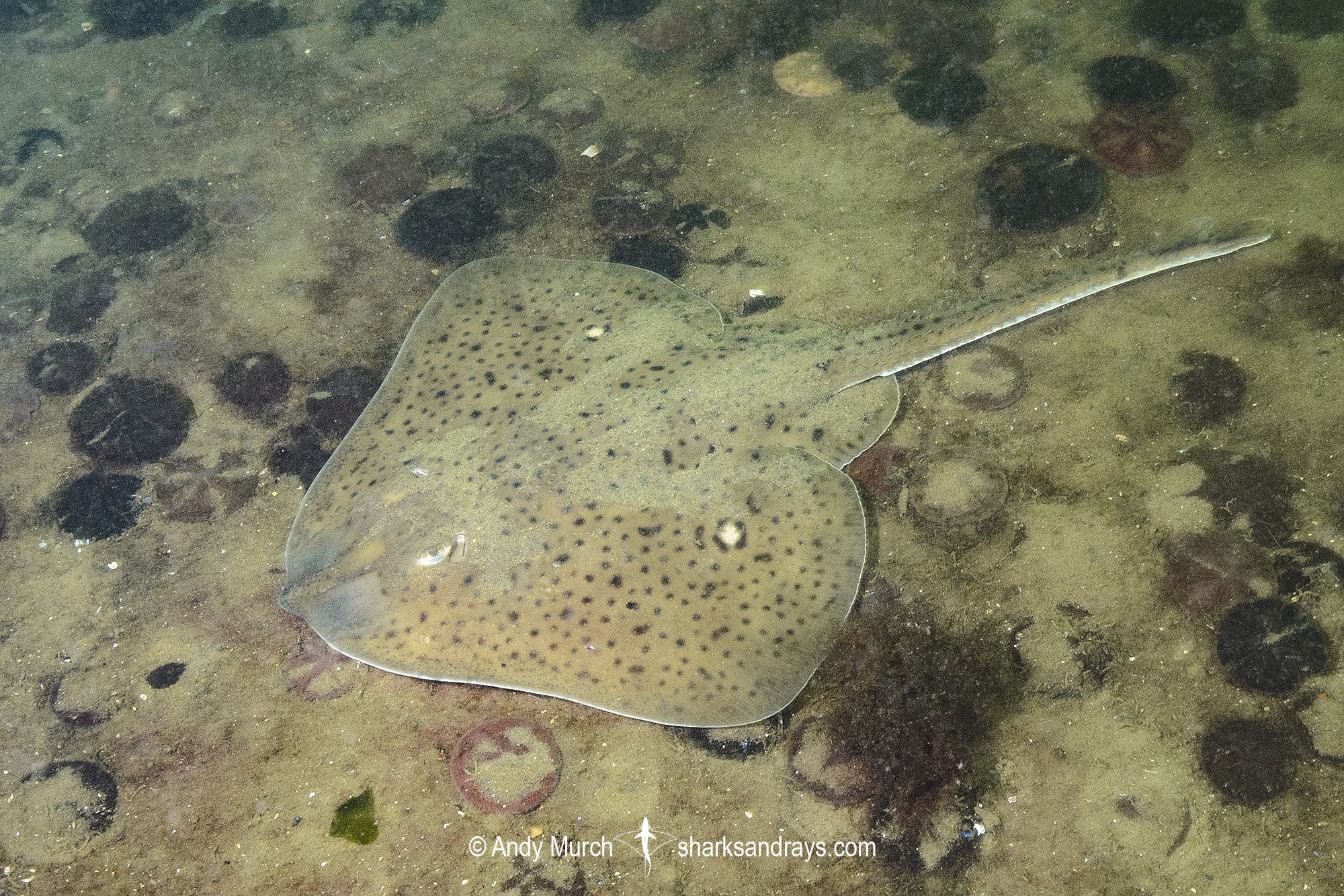Common names
Winter Skate.
Binomial
Leucoraja ocellata.
Synonyms
Raja ocellata.
Identification
A large skate with a heart-shaped or rounded kite-shaped disc. Disc width 1.3 x disc length. Snout broadly rounded or obtusely angular with a small protruding tip. Snout length 2.6-3.3 x orbit length. Anterior margins of pectoral fins undulate; double convex with a weak central concavity; undulation exaggerated in adult males. Pectoral apices broadly rounded. Dorsal surface without small denticles. Dense patches of thorns and/or spinules present on snout, around eyes, nape, along disc margin, and in a strip along either side of midline. Median row indistinct in adults. Tail with 5 lateral thorn rows, median row absent in adults. Pelvic fins weakly notched. Anterior pelvic lobe much shorter than posterior lobe. Tail tapers gradually to tip. Dorsal fins confluent and broadly rounded.
Colour
Dorsum light brown or grey-brown with numerous small dark spots and 1-4 white or pale ocelli ringed by small black spots. Ventrum white, sometimes with irregular dark blotches posteriorly.
Size
Maximum length 113cm. Egg case length 6-8cm. Length at hatching 11-13cm.

Conservation Status
ENDANGERED
The Winter Skate (Leucoraja ocellata) is captured in trawl, longline, and gillnet fisheries. It is a slow growing species that reaches reproductive maturity at 13 years. In the USA, it is a major component of the skate wing fishery, but in Canada, it is a discarded bycatch. The winter skate underwent very steep decline from international fishing fleets targeting shelf and slope groundfish until the Exclusive Economic Zone was increased to 200 nautical miles from shore in 1977. With the collapse of other ground fish in the 1980s and 90s, north american fleets turned to skates, adding to the species decline.
The population in the southern part of the winter skate’s range is now sustainably fished and is estimated to be increasing at a rate of 2% per year, but the population in Canadian waters decreased by 98% by 2004 when a possession ban on winter skates was finally implemented. Unfortunately, the recovery of the species northern population has been hampered by the rebound of the grey seal population which predates heavily on winter skates.

Habitat
Temperate seas. Demersal on sand or gravel substrates, occasionally on mud and rock. From 5-725m.
Distribution
Northwest Atlantic. Found from North Carolina, USA to Labrador, Canada. Disjunct concentrations of winter skates are found in the Gulf of St Lawrence, the southern Grand Banks/Northeast Scotian Shelf, and southwest Scotian Shelf/all areas south.
Reproduction
Oviparous. Females produce 18-36 egg cases per year. Reproduction occurs year round. Sexual maturity among winter skates occurs at vastly different ages in different regions. In the Gulf of Maine, female age at maturity is 5yrs and have an average life expectancy of 11yrs. Further north on the Scotian Shelf and waters east of the St Lawrence Estuary, females mature at ~13yrs and live until 19yrs.
Diet
Winter skates feed mostly on crustaceans, squids, and bony fishes.
Behavior
Moves inshore during the colder months; hence common name.
Reaction to divers
Somewhat skittish. Some winter skates will tolerate a close approach if attempted very slowly and indirectly i.e. approaching at an angle as if heading past. Rarely stays put once directly engaged.
Diving logistics
Winter skates are quite common off of shallow bays in New England. They are apparently most common in the winter months but I have seen numerous animals during dives in June and August.
A good spot to encounter winter skates is at Back Beach near Rockport on the Cape Ann Peninsula, Massachusetts. Diving off Back Beach is a simple matter of walking in off the beach and kicking out to 10-15m depth while keeping a close eye on the sand.
I have also encountered numerous winter skates in August off of Fort Adams, Newport, Rhode Island.
What’s new
View our full list of updates
Similar species
Little Skate Quite similar in shape and coloration but distinguishable by lack of white centred ocelli on pectoral fins.





